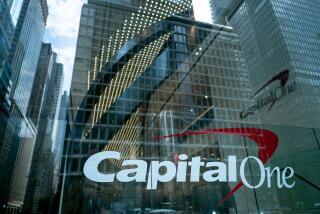East Coast Banks Plan Record-Setting Merger : Finance: First Union agrees to buy First Fidelity in $5.4-billion deal. Bank would stretch from Florida to Connecticut.
- Share via
In America’s biggest-ever bank merger, Charlotte, N.C.-based First Union Corp. agreed to buy First Fidelity Bancorp. of Newark, N.J., in a $5.4-billion stock deal that would create an East Coast giant stretching from Florida to Connecticut.
With 2,000 offices in 13 states and assets of $123.7 billion, the merged institution would replace Chase Manhattan Corp. as the nation’s sixth-largest banking company.
Strongly rising bank stock prices and continuing pressure for greater geographic reach and economies of scale have produced what one analyst called “a very combustible mix” that may result in more big banking mergers this year. In February, Fleet Financial Group Inc. and Shawmut National Corp. signed a $3.6-billion agreement to create the nation’s ninth-largest bank, highly concentrated in New England.
“It’s more and more difficult for mid-size players to compete and offer the same kinds of efficiency as the mega-banks,” said analyst Thomas F. Theurkauf Jr. of New York investment firm Keefe, Bruyette & Woods Inc. “We might see deals that eclipse this one.”
Anticipating that, investors bid up regional bank stocks Monday, helping to fuel a stock market surge.
First Union would pay the equivalent of $64.29 a share for First Fidelity’s stock, a 32% premium over its $48.75 closing price Friday on the New York Stock Exchange. First Fidelity shares soared $10.25 to $59 on Monday, while First Union fell $1.75, closing at $45.875, also on the New York Stock Exchange.
The deal makes sense geographically for First Union by extending its market northward from the mid-Atlantic states into New England. The two companies overlap only in Maryland.
Geographic diversification is becoming an important consideration for banks because it makes them “less susceptible to being overcome by a regional recession,” said Stephen Willard, a banking regulatory attorney with Gibson, Dunn & Crutcher in Washington.
The companies’ products also make for a good fit, analysts said. Both banks concentrate on lending to middle-market firms, those with annual sales of $500 million or less.
Among non-New York-based banks, First Union is one of the most active in capital market finance--stock and bond issues, loan syndications and private placements. In the last two years, it has also aggressively expanded its retail offerings of mutual funds, annuities and other investments through its branches.
After the merger, the company expects to spread its capital-markets and retail-investment activities throughout the six-state area where First Fidelity now operates, a spokeswoman said.
She said that while some corporate positions would be eliminated after the merger, staff reductions would be small because of the minimal overlap. First Union has about 32,000 employees and First Fidelity 12,000.
Although First Union Chairman Edward E. Crutchfield Jr. has been dreaming of a linkup with First Fidelity for three years, serious negotiations between the two companies began about two weeks ago, the spokeswoman said. A definitive merger agreement was signed Sunday.
Analysts said First Fidelity has been quietly “shopping itself” for much of this year.
Under the agreement, First Union would swap 1.35 shares of its common stock for each share of First Fidelity’s common.
One apparent winner in the transaction is Banco Santander, Spain’s largest bank, which holds 23.5 million First Fidelity shares--about 30% of the stock--and has agreed to support the merger. After the combination, Banco Santander would own about 11.4% of First Union’s shares.
The merger, which is subject to regulatory approval and a vote of both companies’ shareholders, is expected to close by Dec. 31. Between now and then, the companies said, they would repurchase up to 5.5 million First Fidelity shares, 7.4 million First Union shares or some combination of the two.
First Union said it would create a new “office of the chairman” for the merged bank. Crutchfield would head the office, retaining his titles of chairman and chief executive. Anthony Terracciano, chairman and chief executive of First Fidelity, would become president, and John R. Georgius, First Union president, would become vice chairman.
In a sign that the deal has not quenched First Union’s appetite, officials from the two companies told analysts Monday that Terracciano would focus on mergers and acquisitions in his new post.
(BEGIN TEXT OF INFOBOX / INFOGRAPHIC)
The Companies at a Glance
First Union Corp. plans to buy First Fidelity Bancorp. for $5.4 billion, the biggest merger ever in the banking industry. The combination would create the nation’s sixth-largest banking company.
FIRST UNION * Headquarters: Charlotte, N.C. * Assets: $88.3 billion (including other pending acquisitions) * Branches: 1,287 * Employees: 32,000 * Regions served: Florida, North Carolina, and Virginia; branches in Tennessee, South Carolina, Georgia and Washington, D.C. * 1994 revenue: $6.3 billion * 1994 profit: $925 million
FIRST FIDELITY * Headquarters: Newark, N.J., and Philadelphia * Assets: $35.4 billion * Branches: 685 * Employees: 12,000 * Regions served: Mainly New Jersey and Pennsylvania; also has branches in New York, Connecticut, Delaware and Maryland * 1994 revenue: $1.4 billion * 1994 profit: $451 million
Source: Associated Press
Banking on Bigness
The five largest U.S. bank mergers:
Value Banks Date (billions) 1. First Union-First Fidelity June, 1995 $5.4 2. BankAmerica Corp.-Security Pacific Corp. August, 1991 4.7 3. NCNB Corp.-C&S;/Sovran Corp. July, 1991 4.5 4. Key Corp.-Society Corp. October, 1993 4.0 5. Fleet Financial Corp.- February, 1995 3.6 Shawmut National Corp.
Source: Keefe, Bruyette & Woods Inc.
More to Read
Sign up for Essential California
The most important California stories and recommendations in your inbox every morning.
You may occasionally receive promotional content from the Los Angeles Times.













